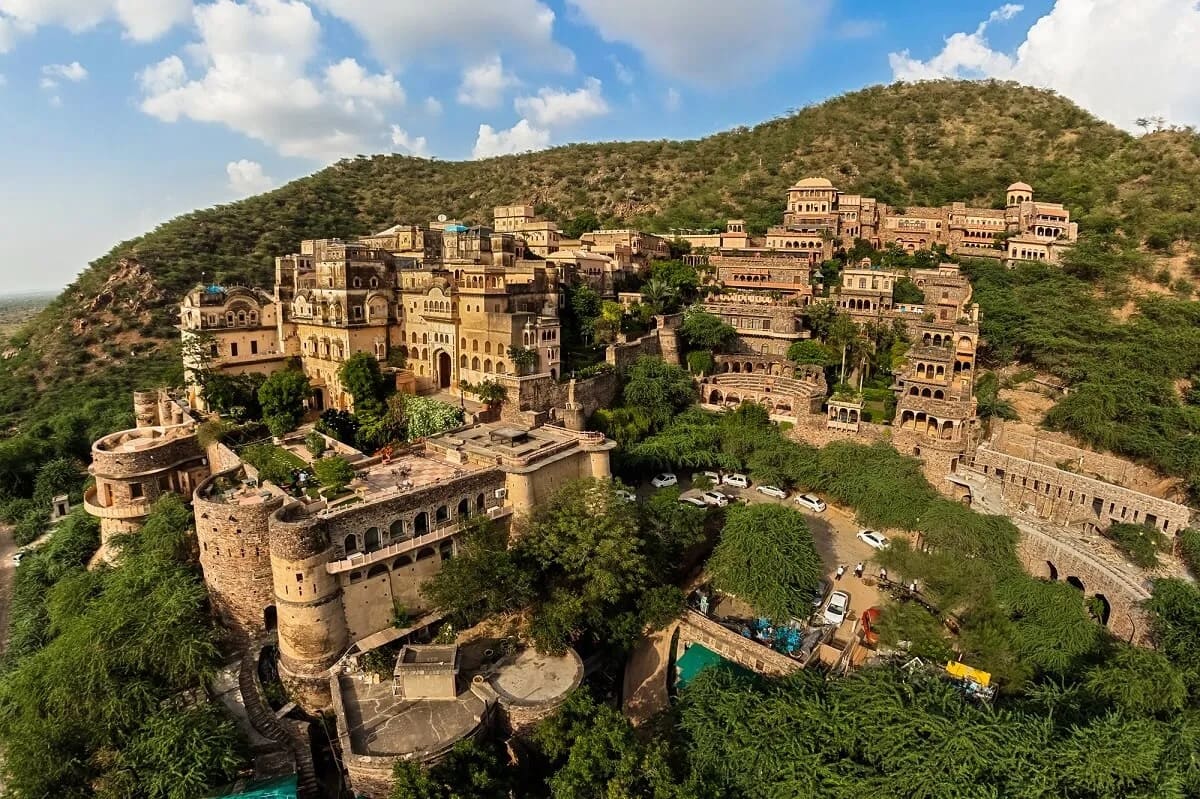Menu

Rajasthan, often synonymous with its vast desert landscapes, showcases a different charm in Alwar, where greenery dominates the scenery. Once a thriving Rajput kingdom, Alwar came under Islamic rule between the 13th and 18th centuries. In 1771, Maharaja Pratap Singh, a Kachhwaha Rajput from Jaipur’s royal lineage, reclaimed Alwar and established his own principality.
Amanbagh
A luxurious retreat that pays homage to the architecture and design of India’s golden age. This elegant resort features a majestic three-story central structure.
Bhangarh
An enchanting historical site, perfect for picnics. The restored medieval bazaar offers a captivating glimpse into the past.
Bharathari
A spiritual pilgrimage center linked to the legend of King Bharathari, who sought penance for doubting his brother, King Vikramaditya of Malwa.
City Palace (Vinay Vilas Palace)
A harmonious blend of Rajput and Mughal architecture, this 18th-century palace now houses government offices on its ground floor.
City Palace Museum
Located in the upper floors of Vinay Vilas Mahal, this museum boasts a collection of rare Persian, Arabic, Urdu, and Sanskrit manuscripts.
Company Garden
A lush retreat with a charming pavilion called ‘Shimla,’ built by Maharaja Mangal Singh in 1885. Ideal for summer visits.
Fateh Jung ka Gumbaj
This cenotaph of Fateh Jung, a minister in Emperor Shah Jahan's court, is renowned for its architectural brilliance.
Hope Circus
Named after Miss Hope, daughter of Lord Linlithgow, this monument is a central landmark between Alwar Railway Station and City Palace.
Jai Pol
This impressive gateway leads to Bala Quila, a colossal fort showcasing Rajput artistry.
Jai Samand Lake
An artificial lake built by Maharaja Jai Singh in 1910, this spot is perfect for picnics and outings.
Karni Mata Temple
Dedicated to Karni Mata, an incarnation of Goddess Kali, this temple reflects late Mughal architectural styles.
Moosi Rani’s Tomb
Built in memory of Moosi Rani, the wife of Maharaja Bakhtawar Singh, this grand cenotaph took nine years to complete (1804–1813).
Moti Doongri
A palace resembling a Scottish castle, Moti Doongri was once the residence of Rajmata Gayatri Devi.
Naldeshwar
This serene village is home to an ancient Mahadev Temple and offers breathtaking views during the monsoon.
Natni ka Baran
A quaint village with a historic Shiva temple, it provides an authentic glimpse into rural Rajasthani life.
Neelkanth Temples
Located within Sariska National Park, these ancient temples, though in ruins, are a testament to Alwar's glorious history.
Neemrana Fort
This picturesque fort, nestled in a horseshoe-shaped valley, has been beautifully restored and is a popular tourist destination.
Nogaza
A remote village offering stunning views of intricately carved ancient temples surrounded by forested hills.
Pandu Pole Hanuman Temple
Built 5,000 years ago, this temple dedicated to Lord Hanuman is steeped in mythology and features a natural water stream.
Sagar
A scenic spot known for its unique Bengali roof and the Moosi Maharani Chhatri.
Sariska National Park
Spanning 800 km², this tiger reserve is home to diverse flora and fauna.
Sariska Palace
Built between 1892 and 1900 as a royal hunting lodge, it now serves as a luxury hotel.
Siliserh Lake
Constructed in 1845 by Maharaja Vinay Singh for his queen, this serene lake is a must-visit.
St. Andrew’s Church
Built during British rule, this charming church reflects the colonial influence in Alwar.
Tavriksha
Located near Sariska Wildlife Sanctuary, this holy site is surrounded by verdant greenery and deep forests.
The Bala Fort (Alwar Fort)
Built by Hasan Khan Mewati in 1550, this fort has seen the rule of Mughals, Marathas, Jats, and Kachhwaha Rajputs.
Vijay Mandir Palace
This picturesque palace overlooking a serene lake features the Sita Ram Temple, attracting devotees during Ramnavami.
Day 1
Day 2
Day 3

Powered by WordPress